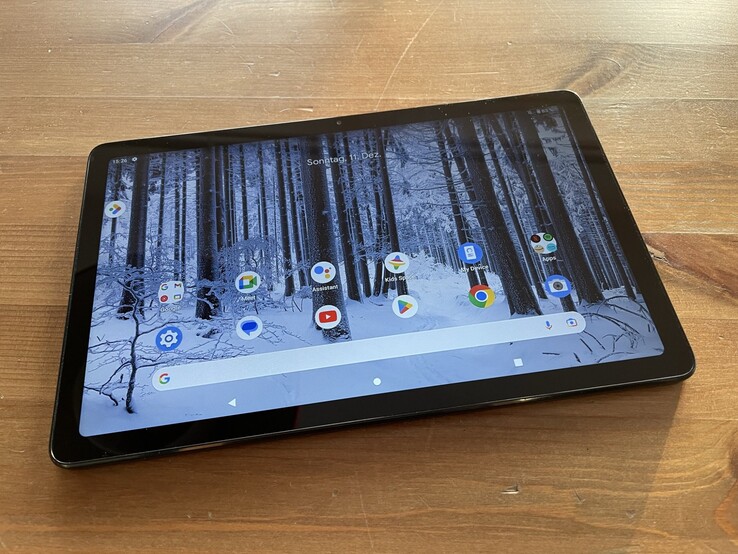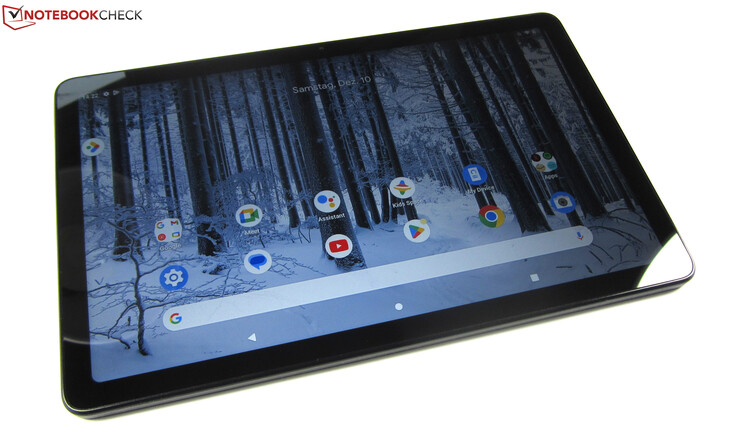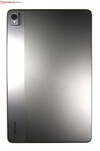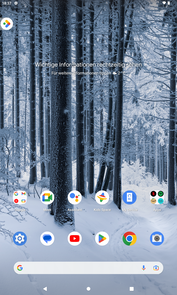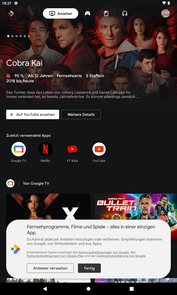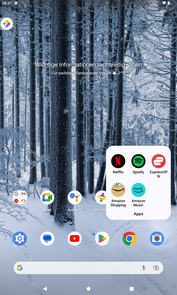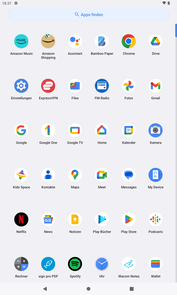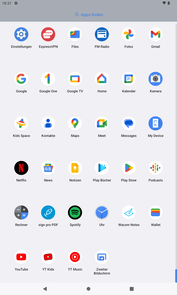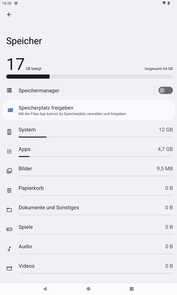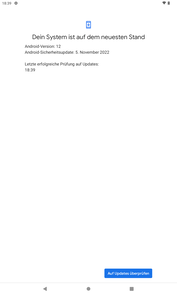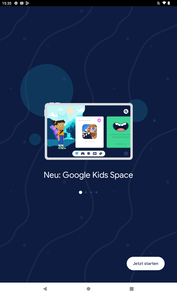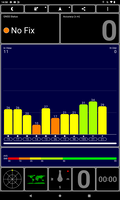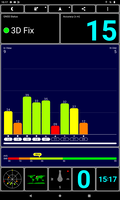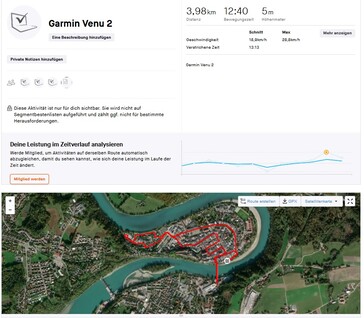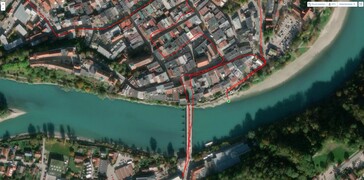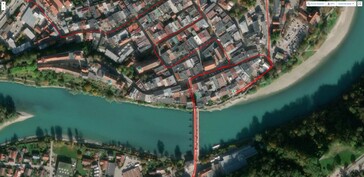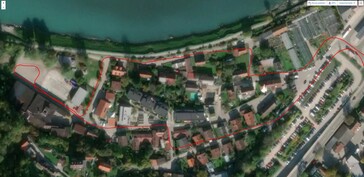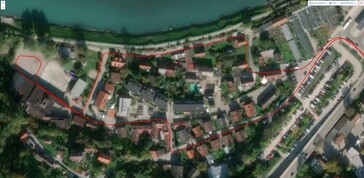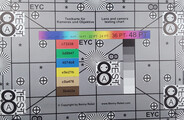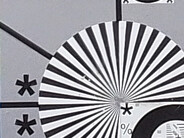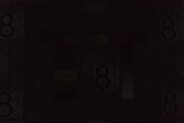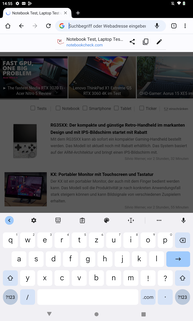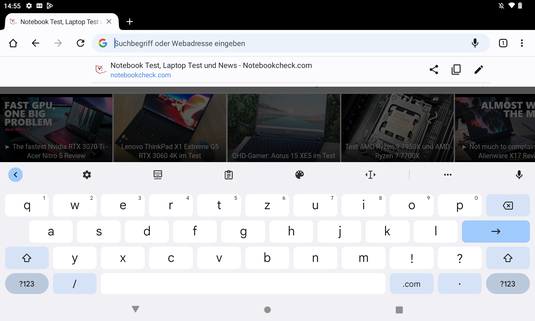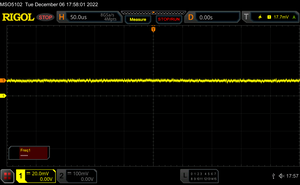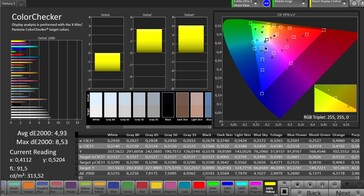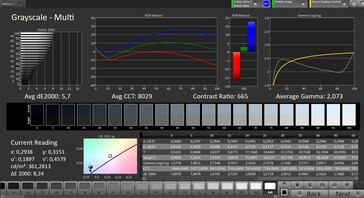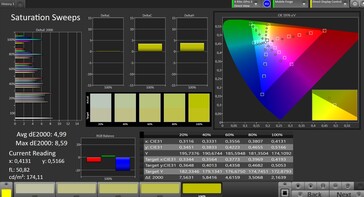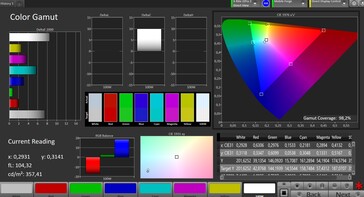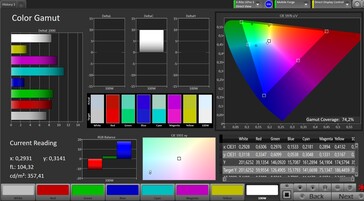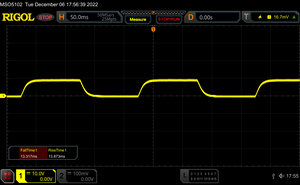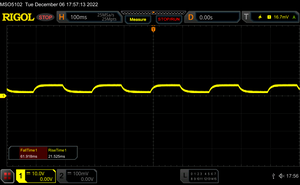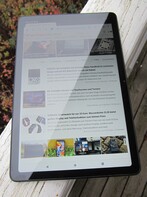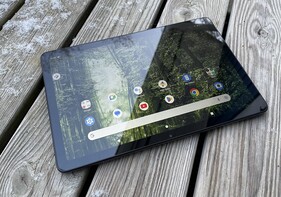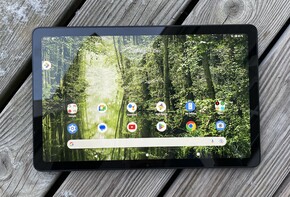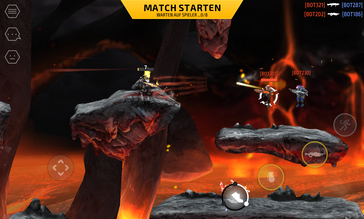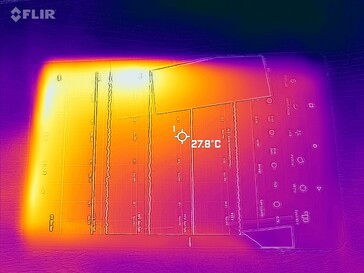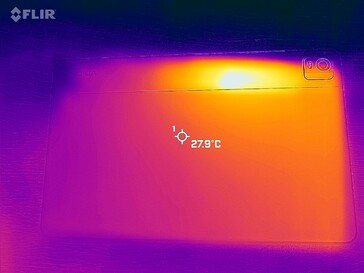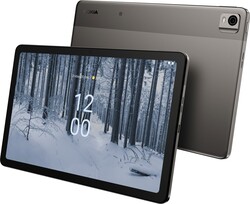Nokia T21 review - Inexpensive tablet for rent as well
Nokia launches a new entry-level tablet, the T21, and positions it as an affordable all-rounder for the office and home. For less than 300 Euros you get a 10.36-inch tablet with a two-tone aluminum chassis and a 2000 x 1200 pixels IPS screen. There is an optional 4G cellular network modem and, as a special feature, stylus support.
The topic of sustainability traditionally plays a big role at Nokia. In order to save valuable resources, the T21 can be rented directly from the manufacturer instead of buying, and the casing is made of 60 percent recycled materials according to the manufacturer.
Possible competitors in comparison
Rating | Date | Model | Weight | Height | Size | Resolution | Price |
|---|---|---|---|---|---|---|---|
| 81.5 % v7 (old) | 01 / 2023 | Nokia T21 T7225 (T612), Mali-G52 MP1 | 466 g | 7.5 mm | 10.36" | 2000x1200 | |
| 80.9 % v7 (old) | 04 / 2022 | Huawei MatePad T10S Kirin 710A, Mali-G51 MP4 | 450 g | 7.85 mm | 10.10" | 1920x1200 | |
| 82.1 % v7 (old) | 11 / 2021 | Nokia T20 T610, Mali-G52 MP2 | 470 g | 7.8 mm | 10.40" | 2000x1200 | |
| 81 % v7 (old) | 02 / 2022 | Samsung Galaxy Tab A8 2022 T618, Mali-G52 MP2 | 508 g | 6.9 mm | 10.50" | 1920x1200 | |
| 80.5 % v7 (old) | 03 / 2022 | Teclast T40 Pro T618, Mali-G52 MP2 | 480 g | 9.2 mm | 10.36" | 2000x1200 | |
| 84.6 % v7 (old) | 12 / 2022 | Xiaomi Redmi Pad Helio G99, Mali-G57 MP2 | 445 g | 7.05 mm | 10.61" | 2000x1200 |
Case - Aluminum chassis and IP52 certification
Externally, you do not notice that Nokia's T21 has an MSRP of less than 300, because it feels quite high-quality and sturdy. The frame and the back of the 10.36-inch tablet, which is relatively light at 466 grams, are made of aluminum. A slightly lighter strip of plastic runs across the entire long side of the back cover, which helps improve the transition between materials and haptics. This gives the Nokia T21 a chic two-tone design. The lighter stripe also features the Nokia lettering and the 8 MP main camera including flash.
Nokia's T21 is protected by resistant glass on the front, but the manufacturer does not provide more detailed information about its protective properties. The IPS screen's 2000 x 1200 pixels resolution is just as high as that of the Nokia T20 and is framed on all sides by an approximately 1-centimeter wide bezel. The IP certification has also remained the same: Nokia's T21 is protected against dust and splash water according to IP52, but it is not waterproof.
Nokia only offers the T21 in one color combination called "Charcoal Gray".
Equipment - Renting instead of buying and optional LTE
Nokia's T21 has 4 GB of RAM and 64 GB of mass storage. Those who opt for the Wi-Fi version (Wi-Fi 5) will pay 249 Euros in Nokia's store at the time of testing. The tablet costs 279 Euros with the additional 4G wireless module.
Instead of buying the tablet, you can also rent it from the manufacturer. This is possible via Nokia's Circular subscription model. In the case of the T21, it is priced at 15 Euros per month and can be canceled with a 3-month notice period. If the tablet is returned, another subscriber receives it in line with the sustainability claim. According to the manufacturer, older devices will not end up in landfills, but will either be recycled or donated to charity.
With a 3.5 mm headphone jack, a USB-C port (USB 2.0, USB-OTG compatible), and a microSD slot that can accommodate cards up to 512 GB in size, the physical interfaces of our WiFi test version are quickly listed. In the 4G variant, an additional nano-SIM card fits in the microSD slot. Thanks to the support of DRM Widevine L1, the tablet also plays HD web streams in every variant - a feature that was not available in the predecessor Nokia T20 (Widevine L3).
microSD card reader
With our microSD reference card Angelbird AV Pro V60, the microSD reader of the Nokia T21 achieves a solid performance. The sequential read and write rates of 72.3 MByte/s and 37 MByte/s, respectively, are slightly better than in the Nokia T20 however, there are somewhat stronger performance drops in sequential reading. The Nokia is fast in the copy test and is only beaten by the Samsung Galaxy Tab A8 2022.
| SD Card Reader - average JPG Copy Test (av. of 3 runs) | |
| Samsung Galaxy Tab A8 2022 (Angelbird AV Pro V60) | |
| Nokia T21 (Angelbird V60) | |
| Teclast T40 Pro (Angelbird AV Pro V60) | |
| Huawei MatePad T10S (Angelbird V60) | |
| Nokia T20 (Angelbird V60) | |
| Xiaomi Redmi Pad (Angelbird AV Pro V60) | |
Cross Platform Disk Test (CPDT)
Software - Android 12 and two guaranteed OS upgrades
The T21 runs a largely pure Android 12, which Nokia has only enriched with a handful of third-party apps like Amazon Shopping, Netflix, Spotify, and ExpressVPN. The tools are found in the Apps folder on the home screen and can be uninstalled when not needed.
The software repertoire also includes Nokia's support app My Device as well as the app Kids Space, which parents can use to provide their offspring with child-friendly content. Also preloaded are two apps tailored for pen input: Sign Pro PDF (insert signatures and annotations into documents) and the note-taking and drawing app Bamboo Paper.
Nokia promises to provide its tablet with monthly security updates for 3 years. This is counted from the date of market launch (November 2022). In addition, the T21 is supposed to enjoy two Android operating system upgrades. At the time of testing in early January, the tablet received a system update that brought the Android security patches up to December 2022.
Communication and GNSS - Fast Wi-Fi, moderate GPS
The mobile version of Nokia's T21 supports WiFi 5 and Bluetooth 5.0 as well as NFC and 10 LTE bands. That is not enough for worldwide use, but there should not be any LTE reception problems at least in the EU region. The Wi-Fi version of the tablet lacks NFC, which leaves Wi-Fi 5 and Bluetooth 5.0 as communication channels.
Connected to our reference router Asus ROG Rapture GT-AXE11000, the tablet achieves a good and largely stable WLAN data throughput. With up to 360 MBit/s, it is exactly in the performance range that can also be expected from WiFi 5. Nokia's T21 can thus hold its ground well against the competition.
| Networking | |
| iperf3 transmit AX12 | |
| Nokia T20 | |
| iperf3 receive AX12 | |
| Nokia T20 | |
| iperf3 receive AXE11000 | |
| Xiaomi Redmi Pad | |
| Samsung Galaxy Tab A8 2022 | |
| Teclast T40 Pro | |
| Nokia T21 | |
| Huawei MatePad T10S | |
| iperf3 transmit AXE11000 | |
| Xiaomi Redmi Pad | |
| Nokia T21 | |
| Samsung Galaxy Tab A8 2022 | |
| Teclast T40 Pro | |
| Huawei MatePad T10S | |
Nokia's T21 finds its current position with the help of the satellite navigation systems GPS, Glonass, and Beidou. However, it does not succeed in capturing a signal from the satellite indoors in the test. This changes outdoors, but the accuracy is not too high with a radius of 15 meters around our location.
This does not change much in the practical test. On a short bike ride, Nokia's T21 tends to locate us beside the track rather than on it. Overall, however, it still delivers a relatively useful precision for everyday use.
Cameras - Two 8 MP sensors with snapshot quality
The front and back of Nokia's T21 each feature an 8 MP camera, which is additionally flanked by an LED flash on the back cover. Both cameras record videos in 1080p at 30 frames per second at most and produce a mediocre picture quality, which is still OK for video chats, though.
Those who take pictures with the tablet cannot expect more than snapshot quality either. In good lighting conditions, the pictures do not look bad at all, but even then they are not particularly sharp and also only show few details. These effects are even more pronounced in low-light pictures.
Image comparison
Choose a scene and navigate within the first image. One click changes the position on touchscreens. One click on the zoomed-in image opens the original in a new window. The first image shows the scaled photograph of the test device.
Main cameraMain cameraLowlightWe take another close look at the Nokia T21's main camera in the test lab. It reproduces the test chart quite sharply in optimal lighting conditions. It reproduces the reference colors of the Colorchecker test chart relatively accurately except for darker greens, browns, and blues. However, the color chart and test chart disappear in the dark with 1 lux of residual light.

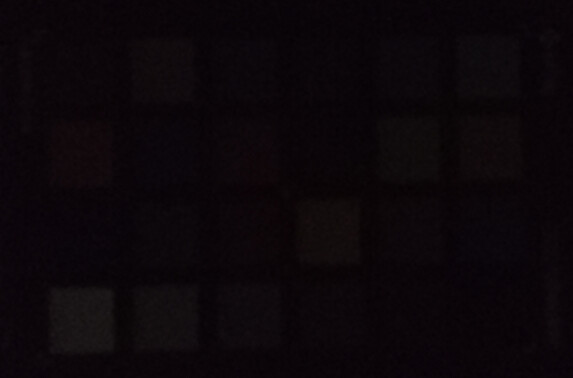
Accessories and warranty - No power supply included
The Nokia T21's scope of delivery includes a USB cable (type A to C), a SIM tool, a safety brochure, and a quick start guide. A suitable power adapter - the tablet supports a maximum of 18 watts of charging current - has to be found by the user. You can find one in Nokia's webshop, where you can choose from power adapters, speakers, headphones, and a flip cover for the T21.
Nokia offers a 24-month warranty for the T21. The manufacturer also offers a 1-year warranty extension for its tablet for an additional charge. However, we could only select it for the LTE variant of the T21 in Nokia's web store at the time of testing.
Input devices & operation - Stylus input is supported
Nokia's tablet can be operated quite smoothly in everyday use. However, you will notice that the hardware in the T21 chassis is not particularly fast. For example, it can sometimes take a while until apps are loaded, menus appear, or switching from one app to the next is done.
Nokia's T21 is compatible with third-party styluses that use Wacom's WGP or Wacom Active ES 2.0 pen technology. However, you will have to look for a suitable stylus yourself because Nokia does not include its own stylus with its tablet and does not offer one in the web store.
The T21 does not have a fingerprint sensor. Biometric authentication is only possible via the 2D face scan, which works quickly and smoothly in sufficiently bright ambient light.
Display - Without PWM, but low contrast
Nokia's T21 is equipped with practically the same IPS panel that was already used in the Nokia T20. The resolution of 2000 x 1200 pixels is identical, and there are only minor differences in brightness and picture quality. Only the contrast of our test device is noticeably worse than Nokia's T20 with a weak 682:1.
The tablet screen shines with an average of 381.6 cd/m² and thus does not have too many bright reserves like its predecessor. However, the other comparison devices in this price range are hardly brighter.
The Nokia T21 is well suited for sensitive users because it does not use pulse width modulation for brightness control.
| |||||||||||||||||||||||||
Brightness Distribution: 94 %
Center on Battery: 389 cd/m²
Contrast: 682:1 (Black: 0.57 cd/m²)
ΔE ColorChecker Calman: 4.93 | ∀{0.5-29.43 Ø4.78}
ΔE Greyscale Calman: 5.7 | ∀{0.09-98 Ø5}
98.2% sRGB (Calman 2D)
Gamma: 2.073
CCT: 8029 K
| Nokia T21 IPS, 2000x1200, 10.4" | Huawei MatePad T10S LCD IPS, 1920x1200, 10.1" | Nokia T20 IPS, 2000x1200, 10.4" | Samsung Galaxy Tab A8 2022 TFT-LCD, 1920x1200, 10.5" | Teclast T40 Pro IPS, 2000x1200, 10.4" | Xiaomi Redmi Pad IPS, 2000x1200, 10.6" | |
|---|---|---|---|---|---|---|
| Screen | 10% | 4% | -18% | 17% | 38% | |
| Brightness middle (cd/m²) | 389 | 285 -27% | 389 0% | 368 -5% | 433 11% | 418 7% |
| Brightness (cd/m²) | 382 | 282 -26% | 368 -4% | 346 -9% | 412 8% | 402 5% |
| Brightness Distribution (%) | 94 | 91 -3% | 84 -11% | 91 -3% | 86 -9% | 90 -4% |
| Black Level * (cd/m²) | 0.57 | 0.3 47% | 0.23 60% | 0.61 -7% | 0.48 16% | 0.28 51% |
| Contrast (:1) | 682 | 950 39% | 1691 148% | 603 -12% | 902 32% | 1493 119% |
| Colorchecker dE 2000 * | 4.93 | 3.53 28% | 8.07 -64% | 6.9 -40% | 3 39% | 2.3 53% |
| Colorchecker dE 2000 max. * | 8.53 | 5.84 32% | 13.81 -62% | 11.4 -34% | 7.2 16% | 5.4 37% |
| Greyscale dE 2000 * | 5.7 | 6.2 -9% | 7.9 -39% | 7.7 -35% | 4.4 23% | 3.7 35% |
| Gamma | 2.073 106% | 2.044 108% | 2.063 107% | 2.16 102% | 2.12 104% | 2.21 100% |
| CCT | 8029 81% | 8130 80% | 8943 73% | 8547 76% | 7003 93% | 6595 99% |
* ... smaller is better
Screen Flickering / PWM (Pulse-Width Modulation)
| Screen flickering / PWM not detected | |||
In comparison: 53 % of all tested devices do not use PWM to dim the display. If PWM was detected, an average of 8108 (minimum: 5 - maximum: 343500) Hz was measured. | |||
The IPS panel's display is too cool in the default setting, but this can be remedied with a manual white balance in the display settings.
However, users cannot influence the other picture parameters. Thus, you have to live with the already mentioned poor contrast ratio, which makes the color reproduction look pretty pale. The accuracy of the color and grayscale reproduction could also be better, but this should not be noticed in everyday use in contrast to the low contrast.
Display Response Times
| ↔ Response Time Black to White | ||
|---|---|---|
| 27 ms ... rise ↗ and fall ↘ combined | ↗ 13 ms rise | |
| ↘ 14 ms fall | ||
| The screen shows relatively slow response rates in our tests and may be too slow for gamers. In comparison, all tested devices range from 0.1 (minimum) to 240 (maximum) ms. » 67 % of all devices are better. This means that the measured response time is worse than the average of all tested devices (20.2 ms). | ||
| ↔ Response Time 50% Grey to 80% Grey | ||
| 84 ms ... rise ↗ and fall ↘ combined | ↗ 62 ms rise | |
| ↘ 22 ms fall | ||
| The screen shows slow response rates in our tests and will be unsatisfactory for gamers. In comparison, all tested devices range from 0.165 (minimum) to 636 (maximum) ms. » 99 % of all devices are better. This means that the measured response time is worse than the average of all tested devices (31.6 ms). | ||
Thanks to the good viewing angles of the IPS display, Nokia's T21 can also be used outdoors. However, due to the not exactly lush display brightness, content can only be read without problems when using the tablet in a shady place or under an overcast sky.
Performance - UNISOC T612 and 4 GB RAM
With the UNISOC T612 and 4 GB of RAM, Nokia's T21 offers a typical configuration for the class. The tablet is not a speed miracle, but it can hold its own well against the competition. Websites also load quite quickly and the eMMC flash memory is a bit faster than in many competitors.
However, the Nokia T21 is only faster than its predecessor in a few places - in some synthetic benchmarks like AnTuTu and in the browser benchmarks, which is probably due to the newer Chrome version in the latter case.
In the graphics benchmarks, on the other hand, the Nokia T21 usually ends up in last place. This is due to its ARM graphics chip Mali-G52 MP1 which only has one processing core and is thus the slowest variant of the G52 series. The Nokia T20 scores better in the graphics benchmarks because it is equipped with the ARM Mali-G52 MP2. This graphics unit clocks higher than the MP1 and also has 2 cores.
| CrossMark - Overall | |
| Average of class Tablet (227 - 2155, n=54, last 2 years) | |
| Xiaomi Redmi Pad | |
| Teclast T40 Pro | |
| Nokia T21 | |
| Average Unisoc T7225 (T612) (n=1) | |
| Samsung Galaxy Tab A8 2022 | |
| AImark - Score v3.x | |
| Average of class Tablet (138 - 55794, n=52, last 2 years) | |
| Xiaomi Redmi Pad | |
| Nokia T21 | |
| Average Unisoc T7225 (T612) (n=1) | |
| UL Procyon AI Inference for Android - Overall Score NNAPI | |
| Average of class Tablet (2597 - 76852, n=62, last 2 years) | |
| Xiaomi Redmi Pad | |
| Average Unisoc T7225 (T612) (4019 - 4063, n=2) | |
| Nokia T21 | |
| Nokia T20 | |
GFXBench (DX / GLBenchmark) 2.7: T-Rex Onscreen | 1920x1080 T-Rex Offscreen
GFXBench 3.0: on screen Manhattan Onscreen OGL | 1920x1080 1080p Manhattan Offscreen
GFXBench 3.1: on screen Manhattan ES 3.1 Onscreen | 1920x1080 Manhattan ES 3.1 Offscreen
GFXBench: on screen Car Chase Onscreen | 1920x1080 Car Chase Offscreen | on screen Aztec Ruins High Tier Onscreen | 2560x1440 Aztec Ruins High Tier Offscreen | on screen Aztec Ruins Normal Tier Onscreen | 1920x1080 Aztec Ruins Normal Tier Offscreen
| 3DMark / Wild Life Extreme | |
| Xiaomi Redmi Pad | |
| Samsung Galaxy Tab A8 2022 | |
| Teclast T40 Pro | |
| Huawei MatePad T10S | |
| Nokia T20 | |
| Nokia T21 | |
| 3DMark / Wild Life Unlimited Score | |
| Xiaomi Redmi Pad | |
| Teclast T40 Pro | |
| Samsung Galaxy Tab A8 2022 | |
| Huawei MatePad T10S | |
| Nokia T20 | |
| Nokia T21 | |
| 3DMark / Wild Life Score | |
| Xiaomi Redmi Pad | |
| Samsung Galaxy Tab A8 2022 | |
| Teclast T40 Pro | |
| Huawei MatePad T10S | |
| Nokia T20 | |
| Nokia T21 | |
| 3DMark / Sling Shot OpenGL ES 3.0 Unlimited | |
| Xiaomi Redmi Pad | |
| Teclast T40 Pro | |
| Samsung Galaxy Tab A8 2022 | |
| Nokia T20 | |
| Nokia T21 | |
| Huawei MatePad T10S | |
| 3DMark / Sling Shot OpenGL ES 3.0 Unlimited Graphics | |
| Xiaomi Redmi Pad | |
| Teclast T40 Pro | |
| Samsung Galaxy Tab A8 2022 | |
| Nokia T20 | |
| Nokia T21 | |
| Huawei MatePad T10S | |
| 3DMark / Sling Shot OpenGL ES 3.0 Unlimited Physics | |
| Xiaomi Redmi Pad | |
| Teclast T40 Pro | |
| Nokia T21 | |
| Samsung Galaxy Tab A8 2022 | |
| Nokia T20 | |
| Huawei MatePad T10S | |
| 3DMark / Sling Shot Extreme (ES 3.1) Unlimited | |
| Xiaomi Redmi Pad | |
| Teclast T40 Pro | |
| Samsung Galaxy Tab A8 2022 | |
| Nokia T20 | |
| Huawei MatePad T10S | |
| Nokia T21 | |
| 3DMark / Sling Shot Extreme (ES 3.1) Unlimited Graphics | |
| Xiaomi Redmi Pad | |
| Teclast T40 Pro | |
| Samsung Galaxy Tab A8 2022 | |
| Nokia T20 | |
| Huawei MatePad T10S | |
| Nokia T21 | |
| 3DMark / Sling Shot Extreme (ES 3.1) Unlimited Physics | |
| Xiaomi Redmi Pad | |
| Teclast T40 Pro | |
| Nokia T21 | |
| Samsung Galaxy Tab A8 2022 | |
| Nokia T20 | |
| Huawei MatePad T10S | |
| 3DMark / Sling Shot Extreme (Vulkan) Unlimited | |
| Xiaomi Redmi Pad | |
| Teclast T40 Pro | |
| Samsung Galaxy Tab A8 2022 | |
| Nokia T20 | |
| Huawei MatePad T10S | |
| Nokia T21 | |
| 3DMark / Sling Shot Extreme (Vulkan) Unlimited Graphics | |
| Xiaomi Redmi Pad | |
| Teclast T40 Pro | |
| Samsung Galaxy Tab A8 2022 | |
| Nokia T20 | |
| Huawei MatePad T10S | |
| Nokia T21 | |
| 3DMark / Sling Shot Extreme (Vulkan) Unlimited Physics | |
| Xiaomi Redmi Pad | |
| Teclast T40 Pro | |
| Nokia T21 | |
| Nokia T20 | |
| Samsung Galaxy Tab A8 2022 | |
| Huawei MatePad T10S | |
| 3DMark / Sling Shot Extreme (ES 3.1) | |
| Xiaomi Redmi Pad | |
| Teclast T40 Pro | |
| Samsung Galaxy Tab A8 2022 | |
| Nokia T20 | |
| Huawei MatePad T10S | |
| Nokia T21 | |
| 3DMark / Sling Shot Extreme (ES 3.1) Graphics | |
| Xiaomi Redmi Pad | |
| Teclast T40 Pro | |
| Samsung Galaxy Tab A8 2022 | |
| Huawei MatePad T10S | |
| Nokia T20 | |
| Nokia T21 | |
| 3DMark / Sling Shot Extreme (ES 3.1) Physics | |
| Xiaomi Redmi Pad | |
| Teclast T40 Pro | |
| Nokia T21 | |
| Samsung Galaxy Tab A8 2022 | |
| Nokia T20 | |
| Huawei MatePad T10S | |
| 3DMark / Sling Shot OpenGL ES 3.0 | |
| Xiaomi Redmi Pad | |
| Teclast T40 Pro | |
| Samsung Galaxy Tab A8 2022 | |
| Nokia T20 | |
| Nokia T21 | |
| Huawei MatePad T10S | |
| 3DMark / Sling Shot OpenGL ES 3.0 Graphics | |
| Xiaomi Redmi Pad | |
| Teclast T40 Pro | |
| Samsung Galaxy Tab A8 2022 | |
| Nokia T20 | |
| Huawei MatePad T10S | |
| Nokia T21 | |
| 3DMark / Sling Shot OpenGL ES 3.0 Physics | |
| Xiaomi Redmi Pad | |
| Teclast T40 Pro | |
| Nokia T21 | |
| Samsung Galaxy Tab A8 2022 | |
| Nokia T20 | |
| Huawei MatePad T10S | |
| GFXBench (DX / GLBenchmark) 2.7 / T-Rex Onscreen | |
| Xiaomi Redmi Pad | |
| Samsung Galaxy Tab A8 2022 | |
| Teclast T40 Pro | |
| Huawei MatePad T10S | |
| Nokia T20 | |
| Nokia T21 | |
| GFXBench (DX / GLBenchmark) 2.7 / T-Rex Offscreen | |
| Xiaomi Redmi Pad | |
| Huawei MatePad T10S | |
| Samsung Galaxy Tab A8 2022 | |
| Teclast T40 Pro | |
| Nokia T20 | |
| Nokia T21 | |
| GFXBench 3.0 / Manhattan Onscreen OGL | |
| Xiaomi Redmi Pad | |
| Samsung Galaxy Tab A8 2022 | |
| Teclast T40 Pro | |
| Huawei MatePad T10S | |
| Nokia T20 | |
| Nokia T21 | |
| GFXBench 3.0 / 1080p Manhattan Offscreen | |
| Xiaomi Redmi Pad | |
| Huawei MatePad T10S | |
| Samsung Galaxy Tab A8 2022 | |
| Teclast T40 Pro | |
| Nokia T20 | |
| Nokia T21 | |
| GFXBench 3.1 / Manhattan ES 3.1 Onscreen | |
| Xiaomi Redmi Pad | |
| Samsung Galaxy Tab A8 2022 | |
| Teclast T40 Pro | |
| Huawei MatePad T10S | |
| Nokia T20 | |
| Nokia T21 | |
| GFXBench 3.1 / Manhattan ES 3.1 Offscreen | |
| Xiaomi Redmi Pad | |
| Huawei MatePad T10S | |
| Samsung Galaxy Tab A8 2022 | |
| Teclast T40 Pro | |
| Nokia T20 | |
| Nokia T21 | |
| GFXBench / Car Chase Onscreen | |
| Xiaomi Redmi Pad | |
| Samsung Galaxy Tab A8 2022 | |
| Huawei MatePad T10S | |
| Teclast T40 Pro | |
| Nokia T20 | |
| Nokia T21 | |
| GFXBench / Car Chase Offscreen | |
| Xiaomi Redmi Pad | |
| Samsung Galaxy Tab A8 2022 | |
| Huawei MatePad T10S | |
| Teclast T40 Pro | |
| Nokia T20 | |
| Nokia T21 | |
| GFXBench / Aztec Ruins High Tier Onscreen | |
| Xiaomi Redmi Pad | |
| Samsung Galaxy Tab A8 2022 | |
| Teclast T40 Pro | |
| Huawei MatePad T10S | |
| Nokia T20 | |
| Nokia T21 | |
| GFXBench / Aztec Ruins High Tier Offscreen | |
| Xiaomi Redmi Pad | |
| Samsung Galaxy Tab A8 2022 | |
| Teclast T40 Pro | |
| Huawei MatePad T10S | |
| Nokia T20 | |
| Nokia T21 | |
| GFXBench / Aztec Ruins Normal Tier Onscreen | |
| Xiaomi Redmi Pad | |
| Samsung Galaxy Tab A8 2022 | |
| Teclast T40 Pro | |
| Huawei MatePad T10S | |
| Nokia T20 | |
| Nokia T21 | |
| GFXBench / Aztec Ruins Normal Tier Offscreen | |
| Xiaomi Redmi Pad | |
| Samsung Galaxy Tab A8 2022 | |
| Teclast T40 Pro | |
| Nokia T20 | |
| Nokia T21 | |
| Huawei MatePad T10S | |
| Jetstream 2 - 2.0 Total Score | |
| Average of class Tablet (22.3 - 395, n=67, last 2 years) | |
| Xiaomi Redmi Pad (Chrome 107.0.5304.105) | |
| Nokia T21 (Chrome 108.0.5359.79) | |
| Average Unisoc T7225 (T612) (42.1 - 48.2, n=2) | |
| Samsung Galaxy Tab A8 2022 (Chrome 94.0.4606.85) | |
| Nokia T20 (Chrome 95) | |
| Huawei MatePad T10S (Huawei V12) | |
| WebXPRT 4 - Overall | |
| Average of class Tablet (26 - 376, n=71, last 2 years) | |
| Xiaomi Redmi Pad (Chrome 107.0.5304.105) | |
| Nokia T21 (Chrome 108.0.5359.79) | |
| Average Unisoc T7225 (T612) (n=1) | |
| WebXPRT 3 - Overall | |
| Average of class Tablet (39 - 480, n=25, last 2 years) | |
| Xiaomi Redmi Pad (Chrome 107.0.5304.105) | |
| Teclast T40 Pro (Chrome 98) | |
| Samsung Galaxy Tab A8 2022 (Chrome 94.0.4606.85) | |
| Nokia T21 (Chrome 108.0.5359.79) | |
| Average Unisoc T7225 (T612) (n=1) | |
| Huawei MatePad T10S (Huawei V12) | |
| Speedometer 2.0 - Result 2.0 | |
| Average of class Tablet (2.59 - 790, n=55, last 2 years) | |
| Xiaomi Redmi Pad (Chrome 107.0.5304.105) | |
| Samsung Galaxy Tab A8 2022 (Chrome 94.0.4606.85) | |
| Nokia T20 (Chome 95) | |
| Nokia T21 (Chrome 108.0.5359.79) | |
| Average Unisoc T7225 (T612) (31.4 - 31.9, n=2) | |
| Huawei MatePad T10S (Huawei V12) | |
| Octane V2 - Total Score | |
| Average of class Tablet (763 - 138481, n=95, last 2 years) | |
| Xiaomi Redmi Pad (Chrome 107.0.5304.105) | |
| Teclast T40 Pro (Chrome 98) | |
| Nokia T21 (Chrome 108.0.5359.79) | |
| Average Unisoc T7225 (T612) (n=1) | |
| Samsung Galaxy Tab A8 2022 (Chrome 94.0.4606.85) | |
| Huawei MatePad T10S (Huawei V12) | |
| Mozilla Kraken 1.1 - Total | |
| Huawei MatePad T10S (Huawei V12) | |
| Samsung Galaxy Tab A8 2022 (Chrome 94.0.4606.85) | |
| Average Unisoc T7225 (T612) (n=1) | |
| Nokia T21 (Chrome 108.0.5359.79) | |
| Teclast T40 Pro (Chrome 98) | |
| Average of class Tablet (243 - 27101, n=80, last 2 years) | |
| Xiaomi Redmi Pad (Chrome 107.0.5304.105) | |
* ... smaller is better
| Nokia T21 | Huawei MatePad T10S | Nokia T20 | Samsung Galaxy Tab A8 2022 | Teclast T40 Pro | Xiaomi Redmi Pad | Average 64 GB eMMC Flash | Average of class Tablet | |
|---|---|---|---|---|---|---|---|---|
| AndroBench 3-5 | -22% | -36% | -21% | 9% | 275% | -20% | 416% | |
| Sequential Read 256KB (MB/s) | 266.46 | 302.9 14% | 159.3 -40% | 255.1 -4% | 260.9 -2% | 976.9 267% | 277 ? 4% | 1795 ? 574% |
| Sequential Write 256KB (MB/s) | 195.53 | 99 -49% | 184.3 -6% | 101.1 -48% | 199.2 2% | 883.6 352% | 178.4 ? -9% | 1342 ? 586% |
| Random Read 4KB (MB/s) | 78.85 | 51.1 -35% | 16.3 -79% | 68.3 -13% | 94.2 19% | 250.82 218% | 60.7 ? -23% | 246 ? 212% |
| Random Write 4KB (MB/s) | 71.2 | 57.8 -19% | 58.2 -18% | 57.5 -19% | 83.6 17% | 257.02 261% | 33.8 ? -53% | 280 ? 293% |
Games - Smooth play possible
Although the Nokia T21 has to do with a slightly weaker graphics chip than the Nokia T20, its power is still sufficient to render current games smoothly. The graphics details usually have to be turned down or, as in PUBG Mobile, only a medium setting like "HD" and "high" can be selected. However, the tactical shooter can be played well and runs with 30 FPS almost all the time. In the graphically less demanding Armajet, 60 FPS is also possible, but the constantly dropping frame rate shows that the tablet already reaches its performance limits here.
We determine the gaming frame rates with our test tool Gamebench.
Emissions - Full power always available
Temperature
In operation, the Nokia T21 remains cool both on the surface and internally even after a 1-hour stress test. With a maximum of 33.5 °C, the tablet does not even get lukewarm, and as 3DMark's Wild Life stress tests show, it can practically access its full performance at any time.
3DMark Wild Life Stress Test
(+) The maximum temperature on the upper side is 33.4 °C / 92 F, compared to the average of 33.7 °C / 93 F, ranging from 20.7 to 53.2 °C for the class Tablet.
(+) The bottom heats up to a maximum of 33.5 °C / 92 F, compared to the average of 33.2 °C / 92 F
(+) In idle usage, the average temperature for the upper side is 24 °C / 75 F, compared to the device average of 30 °C / 86 F.
Speaker
The Nokia T21 has stereo speakers that are located on the short sides of the tablet. They can play quite loud without distorting and deliver a solid sound, but it clearly lacks bass.
External audio devices can be connected to the T21 via the 3.5 mm jack or Bluetooth 5.0. Common Bluetooth codecs like aptX and aptX HD are supported.
Nokia T21 audio analysis
(±) | speaker loudness is average but good (79.5 dB)
Bass 100 - 315 Hz
(-) | nearly no bass - on average 25.3% lower than median
(±) | linearity of bass is average (10.8% delta to prev. frequency)
Mids 400 - 2000 Hz
(+) | balanced mids - only 4.9% away from median
(+) | mids are linear (6.4% delta to prev. frequency)
Highs 2 - 16 kHz
(+) | balanced highs - only 2.3% away from median
(+) | highs are linear (3.9% delta to prev. frequency)
Overall 100 - 16.000 Hz
(±) | linearity of overall sound is average (20.4% difference to median)
Compared to same class
» 58% of all tested devices in this class were better, 7% similar, 35% worse
» The best had a delta of 7%, average was 21%, worst was 129%
Compared to all devices tested
» 53% of all tested devices were better, 8% similar, 39% worse
» The best had a delta of 4%, average was 24%, worst was 134%
Samsung Galaxy Tab A8 2022 audio analysis
(+) | speakers can play relatively loud (87.4 dB)
Bass 100 - 315 Hz
(-) | nearly no bass - on average 28.8% lower than median
(±) | linearity of bass is average (12.2% delta to prev. frequency)
Mids 400 - 2000 Hz
(+) | balanced mids - only 4.3% away from median
(+) | mids are linear (5.4% delta to prev. frequency)
Highs 2 - 16 kHz
(+) | balanced highs - only 4.7% away from median
(+) | highs are linear (6.7% delta to prev. frequency)
Overall 100 - 16.000 Hz
(±) | linearity of overall sound is average (19.9% difference to median)
Compared to same class
» 56% of all tested devices in this class were better, 7% similar, 37% worse
» The best had a delta of 7%, average was 21%, worst was 129%
Compared to all devices tested
» 50% of all tested devices were better, 7% similar, 43% worse
» The best had a delta of 4%, average was 24%, worst was 134%
Energy management - Hard to keep down in everyday life
Power consumption
Nokia's T21 scores with very low power consumption. It is sometimes much more energy-efficient than the comparison devices in idle and under load. Since it also has the largest battery in the comparison with 8200 mAh, battery, we can hope for long runtimes.
Nokia's T21 can be charged with up to 18 watts and supports the USB Power Delivery standard USB PD 3.0.
| Off / Standby | |
| Idle | |
| Load |
|
Key:
min: | |
| Nokia T21 8200 mAh | Huawei MatePad T10S 5100 mAh | Samsung Galaxy Tab A8 2022 7040 mAh | Teclast T40 Pro 7000 mAh | Xiaomi Redmi Pad 8000 mAh | |
|---|---|---|---|---|---|
| Power Consumption | -42% | -57% | -46% | -30% | |
| Idle Minimum * (Watt) | 1.2 | 1.6 -33% | 1.19 1% | 1.44 -20% | 0.93 22% |
| Idle Average * (Watt) | 1.8 | 2.8 -56% | 4.63 -157% | 3.87 -115% | 4.02 -123% |
| Idle Maximum * (Watt) | 2.5 | 3.5 -40% | 4.68 -87% | 3.91 -56% | 4.07 -63% |
| Load Average * (Watt) | 4.8 | 7.9 -65% | 7.27 -51% | 7.1 -48% | 5.52 -15% |
| Load Maximum * (Watt) | 9.9 | 11.5 -16% | 9.17 7% | 8.88 10% | 6.89 30% |
* ... smaller is better
Power consumption: Geekbench (150 cd/m²)
Power consumption: GFXBench (150 cd/m²)
Battery life
In terms of battery life, the Nokia T21 can take full advantage of its low power consumption and large battery capacity of 8200 mAh.
With 15:29 hours of simulated web surfing and 17:39 hours of playing a video, it is an above-average enduring tablet. Even frequent users should be able to get by with the tablet for more than one or, depending on the application profile, two or more days.
| Nokia T21 8200 mAh | Huawei MatePad T10S 5100 mAh | Nokia T20 8200 mAh | Samsung Galaxy Tab A8 2022 7040 mAh | Teclast T40 Pro 7000 mAh | Xiaomi Redmi Pad 8000 mAh | |
|---|---|---|---|---|---|---|
| Battery runtime | -37% | 12% | -16% | -14% | 28% | |
| Reader / Idle (h) | 31.8 | 22.6 -29% | 32.9 3% | 60.7 91% | ||
| H.264 (h) | 17.7 | 10.4 -41% | 13.7 -23% | 16.2 -8% | ||
| WiFi v1.3 (h) | 15.5 | 9.3 -40% | 17.4 12% | 11.3 -27% | 13.4 -14% | 17.6 14% |
| Load (h) | 4.6 | 2.9 -37% | 3.8 -17% | 5.2 13% |
Pros
Cons
Verdict
Nokia's T21 is a good tablet that offers a few advantages at a price of under 300 Euros, starting with the chic metal casing and IP52 certification. The long battery runtimes are a clear highlight. However, the pen input option, the optional LTE, and the DRM Widevine L1 support that is now included compared to the predecessor also scores plus points.
In terms of performance, Nokia's entry-level tablet is just as inconspicuous as the Nokia T20 but has become slightly worse in graphics calculations. Nevertheless, the performance is sufficient to guarantee a relatively smooth operation. Games are also quite fun on Nokia's T21 when the graphics details are adjusted accordingly.
Nokia's T21 is a good entry-level tablet with optional pen input that is also suitable for entertainment fans due to DRM Widevine L1 support.
As expected, Nokia's T21 does not win any trophies in terms of camera, but it shares this fate with many other tablets from the same price range. However, the picture quality is still sufficient for video chats.
There are many alternatives to Nokia's T21. If you look in the same price range, for example, the Xiaomi Redmi Pad is a good choice. It has a much faster SoC, a 90 Hz screen, and 4 speakers, but does not come with LTE and a pen option. Again with the LTE module, you can buy the Samsung Galaxy Tab A8 2022 which is quite similar to Nokia's T21 in terms of performance and features but is available for less than 200 Euros.
Price and availability
You have to pay 249 Euros for the Nokia T21 in the manufacturer's web store if you opt for the Wi-Fi version. It costs 279 Euros with the LTE module. The tablet is hard to find in other web stores at the time of testing, but is usually available at a lower price, for example at Cyberport.
Nokia T21
- 01/13/2023 v7 (old)
Manuel Masiero




